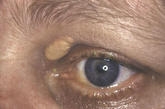www.augenklinik-stralsund.de/en/clinical-characteristics/eyelid-disorders
Augenklinik Stralsund, Praxis Dr. med. M. Fechner
D-18435 Stralsund
Große Parower Straße 47
Klinikum am Sund
3rd Floor
Contact
Tel: +49 3831 380002
Fax: +49 3831 380003
a) dermatochalasis
In the course of life, the elasticity of the eyelid skin deteriorates; it can come to the development of a skin surplus (dermatochalasis) which may cosmetically and – in extreme cases – due to the constriction of the field of vision functionally be disturbing. Apart from that, due to the prolapsing of the intraorbital contents, so-called lacrimal sacs may develop (orbital fat prolapse).
b) malposition of the eyelids
Rarely congenital or acquired by accidents, paralyses or certain diseases, but often as a sign of old age, a loosening of the longitudinal tension of the lower lid can cause an outward rotation of the lid margin (ektropion), by which the lacrimal drainage is not ensured any longer and the patient is irritated by a permanent watering of the eye as well as a chronical conjunctivitis. On the other hand it may come to an inward rotation of the lid margin (entropion) with the consequence that, due to the chafing lashes on the cornea, the eye is irritated.
When the elevating mechanism of the upper eyelid loses its function, a drooping eyelid develops (ptosis), which may cause – depending on the extent – a merely cosmetical or even a functional disturbance of the eye.
c) inflammation
Predisposition or a malposition of the eyelid can cause an inflammation of the eyelids (blepharitis). An acute, painful inflammation of the eyelid is called stye (hordeolum), a chronical, inflamed, mostly circumscribed swelling of the eyelid is called hailstone (chalazion).
d) tumours
With advancing age, there is a multitude of small tumours at the eyelids; they are mostly harmless warts but, not rarely, tumours with a small ulcer (basalioma) which locally grow destroyingly and have absolutely to be removed. In any case, tumours with a tendency to grow, a proneness for bleeding, with a local loss of the eyelashes or with a dark pigmentation have to be presented to the ophthalmologist.


